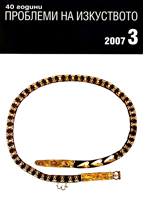Болгарские амулеты в виде конников: евразийский контекст
Bulgarian Horse Amulets in a Eurasian Context
Author(s): Vladimir PetruhinSubject(s): Cultural history
Published by: Институт за изследване на изкуствата, Българска академия на науките
Summary/Abstract: This article examines the motif of the horseman in the religious sculpture of Eurasia, noting the mutual influences between Turkish, Iranian and Finno- Ugric traditions in the Middle Ages and especially Bulgarian amulets depicting a human head on the back of a horse from Pliska and other monuments. The cliff painting at Sakachi-Alyan (in the Amur River basin) is identified as being one of many Eurasian analogies, where the skull is depicted on top of the body of a horse, as in Ob-Ugrian religious objects (hats and saddle-cloths), which were attributes of Mir-Susne-Hum, the horse deity that watches over the world and whose cult is connected with the Iranian cult of Mithra. Bearded faces are a characteristic motif of Turkic early medieval art from Altai to Bulgaria. It is suggested that the face (or head) on top of the horse is an incarnation of the supreme heavenly deity Tengri, the horseman who watches over the world.
Journal: Проблеми на изкуството
- Issue Year: 2007
- Issue No: 3
- Page Range: 3-6
- Page Count: 4
- Content File-PDF

